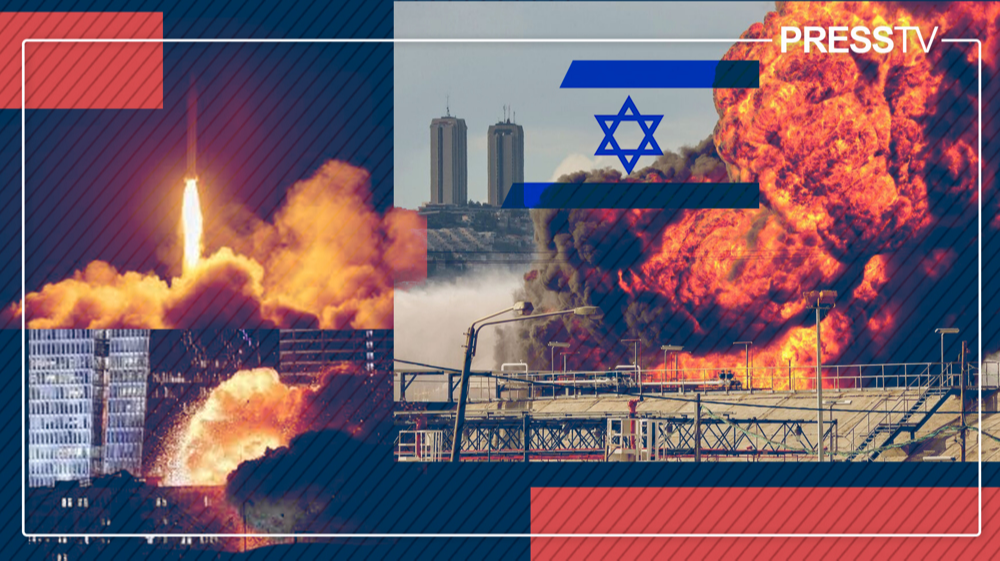
After 12 days of war, the Israeli occupation, which initiated the unprovoked and unlawful armed aggression against Iran, has cowered behind the United States, pleading for a “ceasefire” deal with Iran.
By Musa Iqbal / PRESS TV
The Zionist aggression is over, at least for now. After 12 days of war, the Israeli occupation, which initiated the unprovoked and unlawful armed aggression against Iran on June 13, has cowered behind the United States, pleading for a “ceasefire” deal with Iran.
After getting pounded for 12 days, it was the embattled Israeli regime headed by a war criminal that was forced to halt its surrender. It was not the Islamic Republic of Iran that approached the U.S., but Benjamin Netanyahu, who realized Iran is not Lebanon or Syria.
You may have started the aggression, but it is the Islamic Republic that ended it on its own terms. The Israeli regime, abandoned by its masters in Washington, had no choice but to surrender.
Brokered by the U.S. and Qatar, it is a vague agreement that has, thus far, not been formalized on paper, though both sides, as well as the United States, have recognized it to some extent.
What this 12-day war revealed is the Zionist miscalculation in its much-hyped abilities, and at the same time, astounding Iranian military prowess.
Israeli aggression and the Iranian response
One must remember that the war started with unprovoked Zionist aggression against Iran on June 13th, when the Zionist entity launched airstrikes at residential areas and military targets alike, conducting assassinations of military leaders, public officials, and nuclear scientists.
The stated goals of the Zionist aggression were initially to disable Iran’s nuclear capacities completely and later evolved to regime change, with Israeli PM Benjamin Netanyahu urging Iranians to revolt. It also included the destruction of Iran’s long-range missile capabilities.
The Zionist occupation also used infiltrators armed with drones and car bombs to carry out assassination campaigns as well as inflict psychological terror on the Iranian people.
These agents were quickly rooted out by the highly capable and brave Iranian forces.
None of the stated objectives were met, despite the aggressive tactics used by the Zionists, including dragging the US into the war on June 22, when B-2 stealth bombers struck three Iranian nuclear facilities.
There is still no confirmation that the aggression stopped Iran’s legitimate and peaceful civilian nuclear energy program. There is also no confirmation that Iran’s enriched uranium was harmed.
Iranian media, including Press TV, have reported that the enriched uranium had already been transferred to a safer location months ago, and the sites had also been evacuated.
One cannot write off that two nuclear powers committed aggression against Iran, with a declared goal of degrading or eliminating its enrichment program as well as “regime change”, and as of the cessation of Zionist aggression, none of those goals were met.
The Israeli regime was forced into a ceasefire agreement because, ultimately, it would not be able to withstand Iran’s sophisticated and powerful missile, drone, and cyber-attacks.
After absorbing the initial Israeli attack, which mirrored the US’s ‘Shock and Awe’ strategy, Iranian armed forces quickly regrouped, replenished, and launched “Operation True Promise III” with a stated goal of continuing the operation until the end of Israeli aggression.
Over the next 11 days, a variety of missile salvos and drone strikes were launched at the Zionist entity, striking the occupation from the south to the north. Iran’s Islamic Revolution Guards Corps (IRGC) delivered painful blows, unleashing a wave of devastation across the occupied territories that far exceeded the successful strikes during True Promise I and II.
The targets ranged from military sites to labs and warehouses associated with the Israeli occupation. The IRGC also targeted key research facilities for weapons development, including the “Weizmann Institute of Science” as well as a “tech park” that hosted big corporations like Microsoft, which develops AI and other offensive tools attributed to the ethnic cleansing of Palestine.
Buildings associated with key officials within the Israeli regime were leveled, as power stations were also targeted to disrupt “business as usual.” Millions of settlers were sent running into shelters multiple times every day, from the early morning to the middle of the night.
The missile and drone strikes evaded the multi-tier air defense systems, including Iron Dome, David’s Sling, Arrow-3, and THAAD aerial defense systems, striking their targets while exhausting aerial interceptors. It was likely the exhaustion of these systems and the need to replenish them that led to the call for a ceasefire.
According to the Wall Street Journal, the daily cost of anti-missile air systems ranged from $10 million to $200 million for Israel. This is likely a conservative estimate.
The IRGC was able to demonstrate different missiles for the first time, including the multi-warhead Kheibar (Qadr-H) ballistic missile, which destroyed and leveled city blocks.
Hypersonic missiles like the Fattah-1 were also used, demonstrating a new era of missile capability being employed by Iranian armed forces. The Sejjil ballistic missile was also employed, which grabbed headlines worldwide due to its unusual maneuverability and massive warhead.
These missiles shook the entity and imposed hundreds of millions of dollars worth of property damage, not taking into account the millions of dollars of interceptor missiles fired to unsuccessfully stop them.
On the topic of the economic toll, the destruction of Israeli buildings and infrastructure, paired with military demands to carry out its failed aggression, has not come cheap. The 12-day aggression has cost the entity nearly billions of dollars, ultimately delivering nothing.
Major corporations have also ceased their activity within the entity. Major airlines have canceled flights to the occupation, as shipping companies like Maersk, responsible for delivering weapons used in the Gaza Genocide, have also paused shipping.
Port cities like Haifa which have been struck relentlessly have paused major operations as Israeli railways have also come to a grinding halt in the south-occupied territories.
Tying up loose ends
The immense failure of the Zionist air force can also not be ignored. Indeed, the occupation air force bombed many targets in Iran, but it was not able to do this on its own.
Within Iran, networks of terrorists, chaos agents, and Mossad-backed opposition were activated to target Iran’s air defense structures, including launchers and radar systems. These elements, once discovered by Iranian authorities, were quickly exposed, destroyed, or detained.
After warehouses full of drones and equipment used to destroy Iranian aerial defense as well as inflict terrorist harm on the Iranian population were discovered, Zionist air offensives became less effective.
The Zionist air force relied on these elements to carry out strikes from within for their offensive to be considered successful. Iranian citizens, together with Iranian authorities, worked to root out these traitors and infiltrators and disable networks of terrorists embedded in Iran over the years.
It is already well documented that for years, Mossad agents infiltrated or recruited terrorists to conduct assassinations of officials and nuclear scientists.
The current war saw a widespread activation of these agents, only for them to be quickly discovered and shut down via a unified effort between common Iranians and Iranian authorities.
The activation of chaos agents and terrorists is a card that, once activated, is hard to play again if aggression renews. In the coming days, more agents will be discovered, and the ones detained now will release information about the whereabouts of collaborators, ultimately exposing the Mossad recruitment process.
What lies next?
As stated earlier, this ceasefire is still not on paper, and ceasefires are typically not respected by Israel. It is very likely that the regime will overstep and breach it, though the timeline is uncertain.
Right now, the occupation needs to lick its wounds after being dealt devastating blows. It needs to restock its interceptors and fix critical military and civil infrastructure, as well as promise its settler occupation that it has full control of the situation.
Furthermore, it needs to restore its economic capabilities, most importantly, re-establishing its ports as safe areas in order to continue receiving key shipments of weapons and resources.
The settler population is likely going to hold more demonstrations against Netanyahu, as they have in the past, for this folly that resulted in widespread destruction and the death and injury of hundreds of settlers. Netanyahu and Trump's inability to confirm the whereabouts of Iran’s enriched uranium also raises questions about the effectiveness of even the American operation.
Meanwhile, despite the horrific targeting of civilian structures within Iran such as hospitals and universities, Iranians are experiencing a rejuvenated national unity. Pride in the effective defense of the nation has already had millions of Iranians marching in support of the armed forces throughout the course of the aggression. Today, a massive victory observation is being held in Tehran.
Iran will use the coming days, weeks, and months to continue to root out infiltrators while replenishing its missile and defense capabilities.
Now that the precedent for direct war with the Zionist occupation has been set, new ways to counter these forces will be developed and implemented.
Finally, Iran has vowed to continue its nuclear program. The targeting of the Iranian nuclear structure, though damaging, is not destabilizing. US President Trump insists the program is over, but even American media including some on the same political wing as him are questioning the effectiveness of the illegal American acts of aggression.
If there are any doubts as to who emerged victorious in this war, consider the following: Flights leaving Tel Aviv are completely packed, while Iranians are rallying in the streets.
xxxxxxxxxxxxxxxxxx
Musa Iqbal is a Boston-based researcher and writer with a focus on U.S. domestic and foreign policy.

